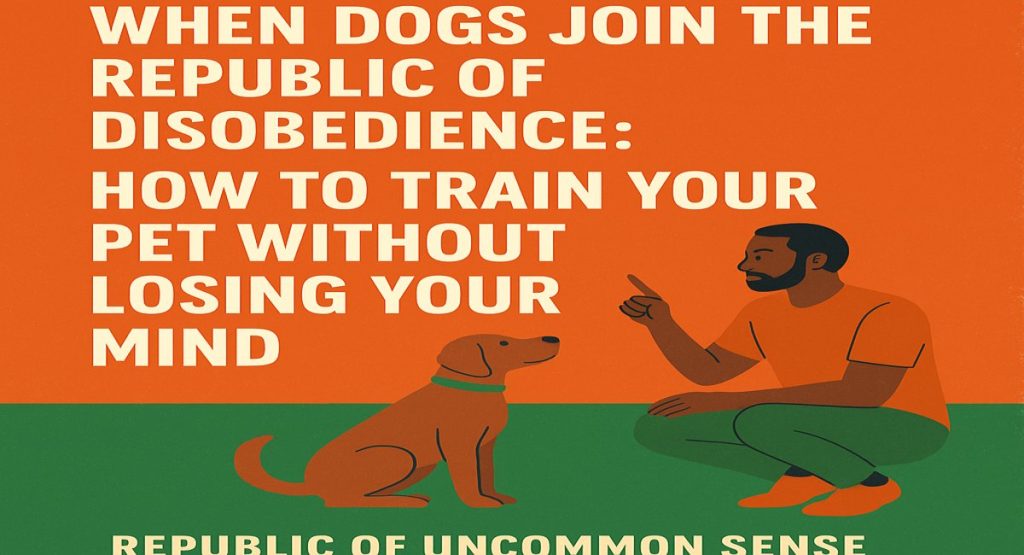One friend’s dog nearly destroyed his marriage. The creature chewed curtains, terrorized visitors, and stole meat with the precision of a seasoned pickpocket. After just two weeks of brain training at home, the “terror” was unrecognizable—sitting calmly, waiting at doors, and rolling over on cue. No shouting. No force. Just brain games and rewards.
Today, the once-rowdy dog is calmer than the average civil servant at lunchtime. And that’s the magic of dog training at home: simple, proven techniques that transform chaos into companionship.
Train smarter, not louder — turn chaos into calm with short, game-based sessions at home.
Introduction — Dog Training at Home in the Republic of Stubborn Dogs
In the Republic of Uncommon Sense, dog training at home can feel like leading a protest march. Dogs no longer fetch slippers on command. They raid the soup pot like MPs raiding the national purse and chew through new sneakers as if auditioning for a demolition job.
And when you shout “sit!”—they stare with the same confusion as a voter decoding a manifesto. Before you surrender to chewed cables and public embarrassment, here’s the good news: a proven, humane way exists to turn chaos into calm—brain training for dogs.
Why Dog Training at Home Fails (and How to Fix It)
The Shouting Method Doesn’t Work
Yelling louder doesn’t make you the alpha—It only amuses the neighbors. Quick-fix classes can also flop; they treat obedience like cramming for exams. Your dog memorizes today and forgets tomorrow.
Dogs Need Brain Stimulation, Not Fear
The root cause of many problems is an under-stimulated mind. When bored, dogs invent entertainment: barking, chewing, jumping, leash pulling, digging, even separation anxiety. The fix is to engage the brain with structured, rewarding games.
What Is Brain Training for Dogs?
A Step-by-Step Online Dog Training Program
Brain Training for Dogs is a clear, video-based program by certified trainer Adrienne Farricelli. It uses positive reinforcement and game-based learning so your dog wants to obey.
Why Brain Training at Home Beats Expensive Classes
- Short, fun lessons: 5–10 minutes—perfect for busy owners.
- Printable plans & videos: Beginner-friendly and mobile-ready.
- Real-life results: Better focus, impulse control, and calm behavior.
Benefits of Dog Training at Home with Brain Training
Stop Barking Without Shock Collars
Teach quiet on cue using reward timing and impulse-control games. No pain, no fear.
End Chewing and Household Chaos
Channel energy into puzzles and nose-work. Chewing becomes optional, not inevitable.
Improve Recall and Leash Manners
Focus-building games make “come” reliable and walks feel like teamwork—not tug-of-war.
Reduce Separation Anxiety
Confidence boosters and gradual desensitization replace pacing and howling with calm.
Further reading: Keep readers on-site with an internal link:
Parliament of Goats: Chapter Five.
Build authority with an external resource:
AKC Dog Training Basics.
How to Start Dog Training at Home in 15 Minutes a Day
10 Easy Dog Training at Home Tips
-
Start with one command at a time – Focus builds faster results than juggling many commands.
-
Keep sessions short – 5–10 minutes, a few times daily works better than long drills.
-
Use high-value treats or toys – Rewards your dog actually craves boost learning.
-
Train before meals – A slightly hungry dog is more motivated to earn treats.
-
End on a positive note – Always finish when your dog succeeds, not fails.
-
Be consistent with words and gestures – Everyone in the house should use the same commands.
-
Avoid punishment – Focus on rewarding good behavior instead of scolding mistakes.
-
Add mental puzzles – Hide treats, use simple games, or rotate toys for stimulation.
-
Mix obedience with play – Combine commands with fun activities like fetch to keep it engaging.
-
Track progress daily – Note improvements; small wins stack into lasting obedience.
Short, Fun Sessions Beat Boot Camps
- Pick one goal: barking, recall, or leash pulling.
- Set rewards: tiny treats or a favorite toy—keep it fun.
- Train in bursts: 5–10 minutes, 2–3 times daily.
- Follow levels: Puppy → Elementary → High School → College → University.
- End on a win: stop while your dog is successful and eager for more.
Use Rewards, Not Punishments
Positive reinforcement builds trust and motivation. Your dog learns faster and enjoys the work—so you do, too.
FAQs About Dog Training at Home
How fast will I see results?
Many owners notice improvements within the first week—especially in focus and impulse control—when practicing short, daily sessions.
Is this suitable for older dogs?
Yes. Senior dogs love brain games. Low-impact activities build confidence and mental sharpness without stressing joints.
Do I need special equipment?
No. Treats, a leash, and simple household items (towels, boxes, toys) are enough.
Is it humane?
Absolutely. The method relies on positive reinforcement—rewarding correct behavior instead of punishing mistakes.
Train Smarter, Not Louder (Final Call to Action)
Ready to graduate from chaos to calm? With dog training at home using brain games, you’ll enjoy quiet evenings, stress-free walks, and a dog that listens the first time.
